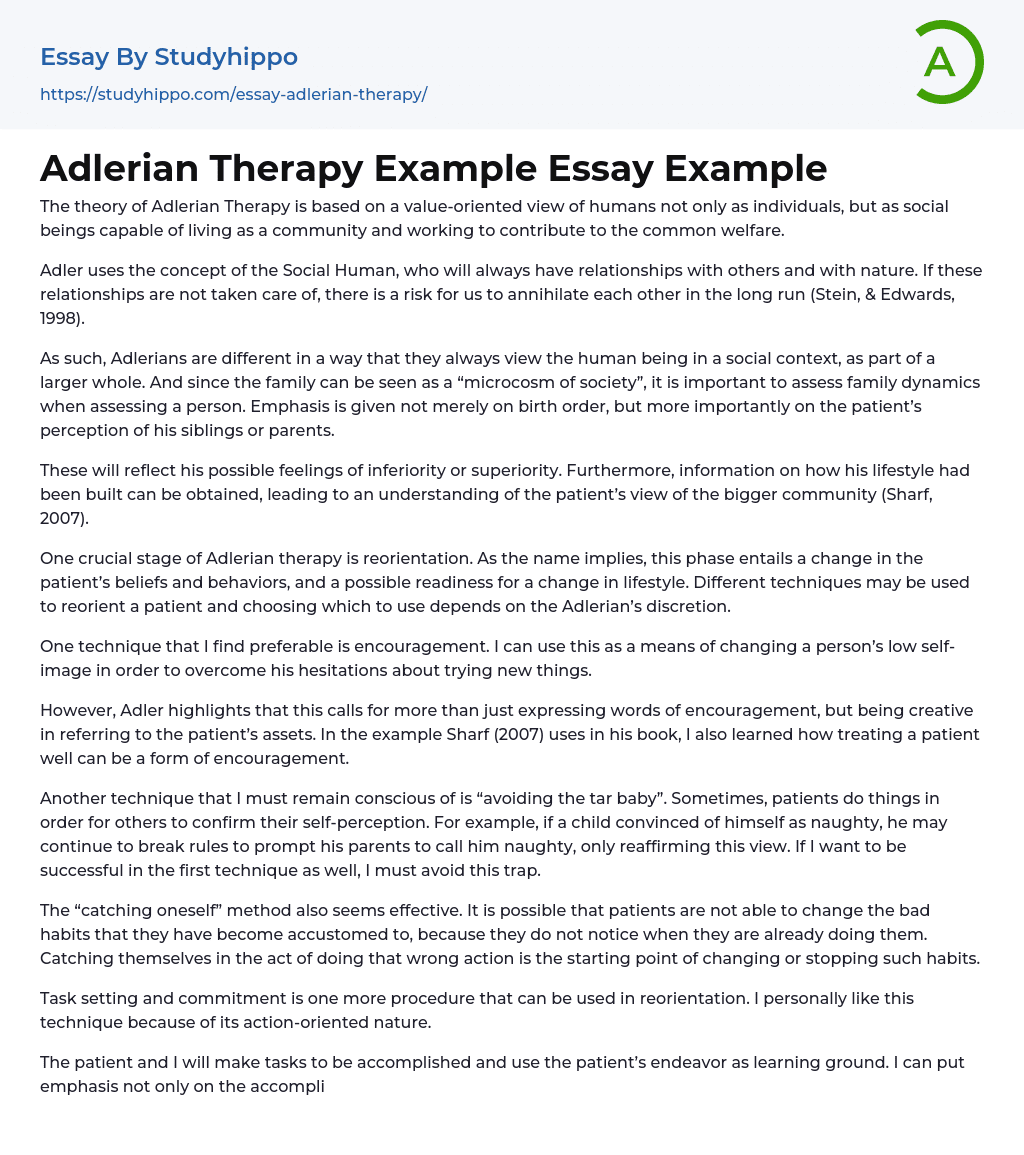The theory of Adlerian Therapy is based on a value-oriented view of humans not only as individuals, but as social beings capable of living as a community and working to contribute to the common welfare.
Adler uses the concept of the Social Human, who will always have relationships with others and with nature. If these relationships are not taken care of, there is a risk for us to annihilate each other in the long run (Stein, & Edwards, 1998).
As such, Adlerians are different in a way that they always view the human being in a social context, as part of a larger whole. And since the family can be seen as a “microcosm of society”, it is important to assess family dynamics when assessing a person. Emphasis is given not merely on birth order, but more importantly on
...the patient’s perception of his siblings or parents.
These will reflect his possible feelings of inferiority or superiority. Furthermore, information on how his lifestyle had been built can be obtained, leading to an understanding of the patient’s view of the bigger community (Sharf, 2007).
One crucial stage of Adlerian therapy is reorientation. As the name implies, this phase entails a change in the patient’s beliefs and behaviors, and a possible readiness for a change in lifestyle. Different techniques may be used to reorient a patient and choosing which to use depends on the Adlerian’s discretion.
One technique that I find preferable is encouragement. I can use this as a means of changing a person’s low self-image in order to overcome his hesitations about trying new things.
View entire sample
justify;">However, Adler highlights that this calls for more than just expressing words of encouragement, but being creative in referring to the patient’s assets. In the example Sharf (2007) uses in his book, I also learned how treating a patient well can be a form of encouragement.
Another technique that I must remain conscious of is “avoiding the tar baby”. Sometimes, patients do things in order for others to confirm their self-perception. For example, if a child convinced of himself as naughty, he may continue to break rules to prompt his parents to call him naughty, only reaffirming this view. If I want to be successful in the first technique as well, I must avoid this trap.
The “catching oneself” method also seems effective. It is possible that patients are not able to change the bad habits that they have become accustomed to, because they do not notice when they are already doing them. Catching themselves in the act of doing that wrong action is the starting point of changing or stopping such habits.
Task setting and commitment is one more procedure that can be used in reorientation. I personally like this technique because of its action-oriented nature.
The patient and I will make tasks to be accomplished and use the patient’s endeavor as learning ground. I can put emphasis not only on the accomplishment of the task, but on the endeavor itself. This technique can help rid the patient of his hesitations on making commitments, and increase his self-esteem as well.
BIBLIOGRAPHY
Stein, H., & Edwards, M. (1998). Classical Adlerian theory and practice. In Psychoanalytic versions of the human
condition: Philosophies of life and their impact on practice. Retrieved June 4, 2009 from http://ourworld.compuserve.com/homepages/hstein/theoprac.htm
Sharf, R. S. (2007). Chapter 4. Adlerian theory of therapy and counseling. In Theories of psychotherapy and counseling: concepts and cases, 127-139.
- Age Of Enlightenment essays
- Ethos essays
- Time essays
- Acceptance essays
- Meaning Of Life essays
- Reality essays
- Natural Law essays
- Political Philosophy essays
- Utilitarianism essays
- Existence essays
- Free Will essays
- Good And Evil essays
- Confucianism essays
- Relativism essays
- Conscience essays
- Environmentalism essays
- Empiricism essays
- Epistemology essays
- Ethics essays
- Existentialism essays
- Human Nature essays
- Individualism essays
- Metaphysics essays
- Philosophy Of Life essays
- Transcendentalism essays
- Truth essays
- Destiny essays
- Determinism essays
- Fate essays
- Functionalism essays
- Philosophers essays
- Pragmatism essays
- Future essays
- Child Observation essays
- Critical Reflection essays
- Teaching Philosophy essays
- Personal Philosophy essays
- Action Speak Louder Than Words essays
- Can Money Buy Happiness essays
- Values of Life essays
- Ethical dilemma essays
- Normative Ethics essays
- Virtue Ethics essays
- Belief essays
- Deontology essays
- Moral essays
- Virtue essays
- Work Ethic essays
- Henry David Thoreau essays
- Carl Jung essays




